It’s that time again. Trout season this year opens on Saturday October 5 so there’s just enough time to check out the tackle and make sure it’s all ready to go.
The fly line can be treated to some proprietary dressing with last year’s leader tippet exchanged for a new one that won’t break as soon as a fish grabs the fly. The reel can be given some TLC via light oil or grease. Thigh waders should be checked for leaks by filling with water and then allowed to dry after repair or given the OK all round and with the vehicle packed with gear it’s time for a run up the range to the New England trout streams (being close to southern Queensland) or further south to the Snowy Mountains area if time permits.
In the car should be a 5-6wt fly fishing outfit, a fishing vest or pack, a landing net, the good-to-go waders, with ready to carry tackle including spare spools of tippet plus a box of wet flies to compliment the box of dry flies. Don’t forget the warm clothing; frosty nights are common in October throughout all NSW trout waters. A fishing license is available online from the State’s Department of Primary Industries web site.
Ebor is the centre of the New England trout fishery, which is very highly regarded with the region being classified as having ‘fast growth’ waters. Around Ebor there are plenty of trout streams easily accessed by roads. Access to waters on private property always requires permission from the landowner which, from my experience, is usually freely given so long as things are left as they are found regarding gates and the like.
There’s been a lot written about how difficult trout can be to catch at times. If brown trout are your target, they can be quite selective in what they eat and hard to tempt with alternatives. For instance, if black beetles are falling from the nearby trees onto the stream there’s not much point in offering a mayfly or grasshopper imitation to a brown trout. They’re keyed in on beetles and are actively looking for them.
Yet overcoming this selective feeding behaviour is as easy as carefully watching what is coming down the stream before putting on a fly to tempt a moving fish. Brown trout also have a frustrating trait of sitting exactly where the really shallow flow is exiting a pool and taking food off the surface in that area. The angler then has only one cast to that fish with the correct fly on the leader and it must be right on the money or the fish is gone in an upstream bow wave. Obviously, accuracy in casting will be a huge asset on trout water.
Fortunately, most fish in New England waters are rainbows, far more forgiving of angler error and a lot less fussy in diet. There’s still a need to cast correctly as no trout will ignore a fly landing on it’s head with a half metre of leader tippet looping all around it. A rapid exit from the area is assured.
Above all, a quiet, stealthy, approach to the water with time taken to properly assess things before making the first cast will shorten the time to a hook up. When a fish is seen moving and taking food from the surface the idea is to check carefully to assess what seems to be on the menu and once identified, cast an imitation of the insect fairly close to the fish and watch for his reaction. A bulge of water under the dry fly always means that the fish has had a look but not taken it. This suggests that you have presented the wrong fly. If the fly does disappear in a swirl the clue is to then watch for the leader to move before lifting the rod to gently set the hook. The selection of dry flies likely to succeed in this early part of the season can be narrowed down to mainly include mayfly imitations. Iron Blue dun, Adams, black spinner, Royal Wulff are all good starting flies, simply because the cooler weather at this time precludes grasshoppers, large brown caddis and large insects like them that will appear in warmer times. Beetles can be about though, and if noticed on the water an appropriate beetle imitation (black or brown) will be necessary.
Whatever fly you choose, it should roughly match the size of the insects noticed. Most times size 16 or 14 will be ideal to imitate mayflies, 12 for beetles. Remember, always grease the leader and fly line with Mucilin dressing to ensure they will float before tying on a dry fly, and cast the fly very gently just above and to the side of the fish so it drifts naturally back to him.
While trout are quite likely to be noticed rising and feeding from the surface at times of lowest light, there’s a definite requirement for a wet fly on the leader when surface activity is shut down or when a stream is discoloured. This latter occurrence is highly possible as this time of year but rest assured that trout will still feed in dirty water so long as they notice the fly. Without doubt the Woolly Bugger in any of it’s forms (size 6 or 8) is the go-to wet fly these days the idea being to use an olive or brown Woolly Bugger in clearer water with the black version on the leader during spates or floods.
Wet fly fishing can still be undertaken with a floating line after removing line dressing with a rub of mud, the idea being to cast upstream and across and work the fly back after it sinks down somewhat in small strips. Keeping the fly rod tip in the water during the retrieve ensures there’s no slack to prevent a hook up when the fly is taken.
Just being on a trout stream this month will be half the fun of it, catching fish is a bonus but still very likely to happen. Trout are reliable in many respects. If the early morning or evening is not too blustery or cold they are pretty sure to rise obligingly which is one of their great attractions. Don’t forget the warm clothes!
Reads: 5235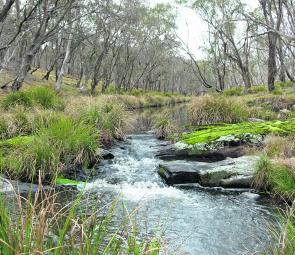
New England’s small water will still hold some quality trout, especially where plenty of steam aeration is taking place.
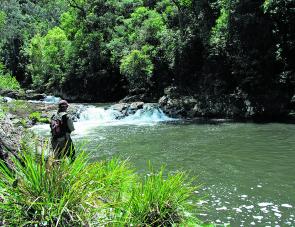
Large pools like this one are the domain of the wet fly. Olive or Black Woolly Bugger are hard flies to go past when fishing deep.
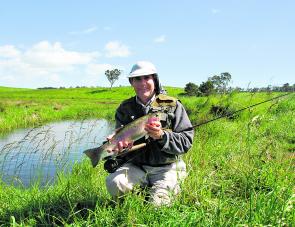
The author with a top quality New England rainbow trout.
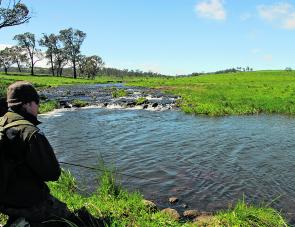
Early morning in the high country, definitely a time for warm clothing.
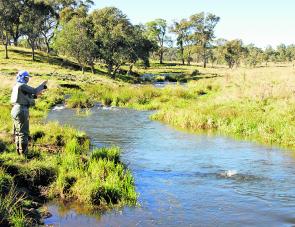
A dry fly cast into the head of the pool resulted in the action we see here.
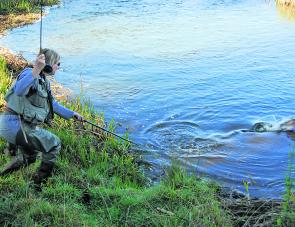
Landing nets are very handy around trout water.

Brown trout, like this one, sitting right at the rear of a run are a one-good-cast proposition. Muff the cast and the fish will be gone in a bow wave!




